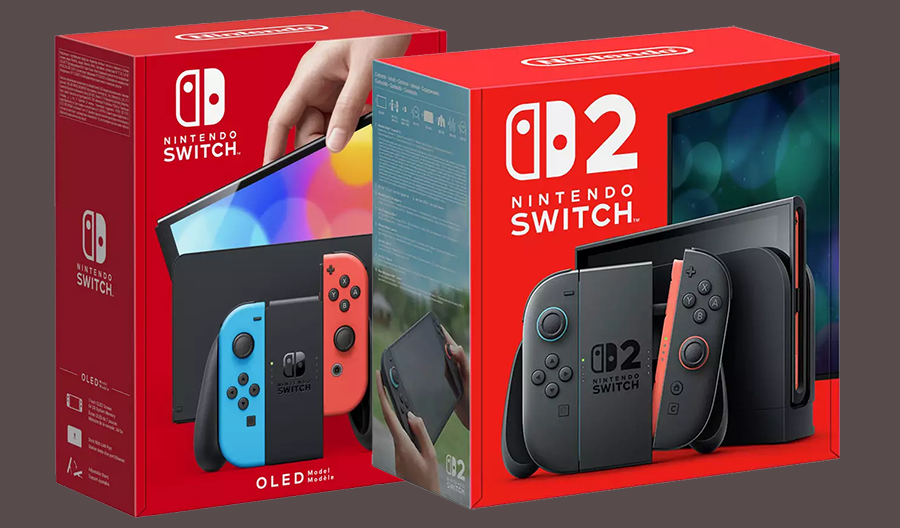
The Nintendo Switch 2 has landed! After years of anticipation awaiting the new console launch, let’s not waste any more time. In this blog we’ll look at the specs and see how it compares to the old model.
First off, the Nintendo Switch 2 has been launched with the promise of significant leaps forward from the original 2017 model. While also retaining the same design that allows for both handheld and TV-connected play, the Switch 2 introduces substantial upgrades in hardware, performance, and user experience.
Below we break down the most common features and specifications, then compare the new Switch 2 to the original and OLED Switch.
The Screen size
The Nintendo Switch 2 has a 7.9-inch screen in comparison with the regular Switch being 6.2 inches and OLED Switch 7.0 inches. As the screen is measured diagonally from corner to corner, nearly two extra inches means a much larger surface area.
Although the screen is bigger, the console is sticking with an LCD screen like the original Switch, foregoing the more expensive OLED screen.
The Joycons
Compared to the original Switch, the Switch 2 Joycons are much bigger in size. When removed from the console, the raised edge features additional buttons for even more accessibility and control.
With bigger shoulder buttons, this makes them easier to use in the mini controller mode, and the thumb sticks are larger to make things more comfortable.
When players detach a Joycon from the Switch 2, additional buttons open the door for more detailed controls.
Underneath the Home button is an extra button marked with a letter C. This enables the Game Chat function, a new feature that allows you to join voice and video calls with other players during a game.
Taking usability a step further, in a potential breakthrough move, certain games now allow you to remove the Joycon and use it as a mouse. This could be especially usefully with first person shooter games, allowing you to aim with a mouse like you would on a PC.
USB-C Port
Another small but useful edition is the addition of a second USB-C port next to the headphone jack which enables greater connectivity when players want to use additional devices.
Tabletop Stand
To some the original Switch the stand felt flimsy and often collapsed under its own weight.
The stand on the Switch 2 is sturdier and more capable of keeping the screen upright and also has the ability to recline further than the original Switch and has extra movement to ensure players can get the perfect angle to see the action unfolding.
The Dock
The dock of the Switch 2 appears to have the same design, which was used with the OLED Switch, but compared with the original Switch, the design is vastly different.
The curve at the top of the dock, along with small feet placed at the bottom, allow for better cooling and air circulation.
When the connected to a TV, the Switch 2 console can out up to 4K resolution at 60Hz which is a significant upgrade from the originals Switch’s maximum 1080p (Full HD).
Internal Storage
The original Switch had 32GB, OLED 64GB, the Switch 2 boasts 256GB.
This increase in storage means plenty of space for games will be available as standard, meaning no need to purchase a memory card. Althoughw ith increased power in the console, it will mean higher file sizes for games and downloads.
RAM
The original Switch had 32GB, OLED 64GB, the Switch 2 boasts 256GB.
With over double the RAM of its predecessor, the Switch 2 is expected to run games that require high-end hardware to cope with demands. So, with this you can expect faster and smoother gaming performance.
Battery life
The Switch 2 has a 5220mAh lithium-ion battery, compared to the Switch and OLED's 4310mAh. This basically means the battery is bigger and more powerful. However, comparing battery life (full charge to empty), it appears the original Switch and OLED models are better on average, than the Switch 2.
That might sound a little disappointing, but it's worth pointing out that the Switch 2 is a much more powerful console, giving a better in-game experience by far. So even though it has a “better” battery, it might still drain slightly quicker due to the improvements elsewhere.
Charge time for the battery remains the same with an average charge time of 3 hours.
Processor Specs
The CPU (Central Processing Unit)
The CPU is the brain of your console. The original Switch came with a Custom Tegra Processor, whereas the new Switch 2 comes with a Custom Nvidia Processor. To some this may make some or little sense! All you need to know if this is a significant upgrade to the processing power.
The GPU (Graphics Processing Unit)
The GPU is what generates the images and video on screen. The original and OLED Switch models had Tegra Processors, where the Switch 2 has a newer and more powerful Nvidia Processor which gives better game play, improved graphics rendering and deliver 4K output.
Final Thoughts
In our opinion the Switch 2 is a wonderful successor to the original Switch models and for some a worthy upgrade over the original and OLED Switch. The price of new consoles and new games will always be a factor, but if that’s not an issue, the Switch 2 enhances nearly every aspect against the original console, while preserving the hybrid gaming experience that make the platform such a success.
For all our Switch 2 consoles, games and accessories visit argos.co.uk